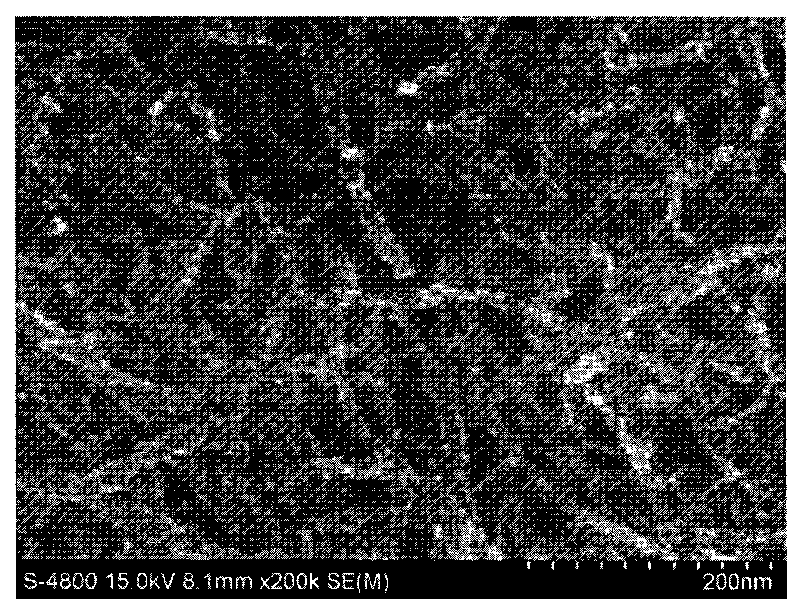Method for preparing stannic oxide battery anode material on carbon nano tube by using electro-deposition process
A carbon nanotube, battery positive electrode technology, applied in battery electrodes, circuits, electrical components, etc., can solve the problems of small binding force between tin dioxide and carbon nanotubes, agglomeration of electrode material particles, and poor reversibility of electrode reactions. The effect of controllable size and macroscopic morphology, fine crystallization and low cost
- Summary
- Abstract
- Description
- Claims
- Application Information
AI Technical Summary
Problems solved by technology
Method used
Image
Examples
Embodiment 1
[0053] Step 1: Configure the electrodeposition solution:
[0054] Electrodeposition solution consists of stannous chloride SnCl 2 , HNO nitrate 3 , sodium nitrate NaNO 3 and deionized water, and then the electrodeposition solution was placed in a water bath with a temperature of 85°C for 60 minutes, and it was set aside for use;
[0055]Dosage: add 0.38g of stannous chloride, 0.27ml of nitric acid and 4.5g of sodium nitrate to 100ml of deionized water;
[0056] Step 2: Preparation of carbon nanotube pole pieces:
[0058] Raw material: carbon nanotubes;
[0059] Binder: PTFE (polytetrafluoroethylene) with a concentration of 60% by mass;
[0060] Dosage: Add 2g of carbon nanotubes and 0.1g of PTFE to 100ml of ethanol;
[0061] After mixing the above raw materials evenly, drying at a temperature of 100° C. for 50 minutes, taking it out to obtain a viscous substance with certain flexibility;
[0062] Then, the viscous material was continuously rol...
Embodiment 2
[0075] Step 1: Configure the electrodeposition solution:
[0076] Electrodeposition solution consists of stannous chloride SnCl 2 , HNO nitrate 3 , sodium nitrate NaNO 3 and deionized water, and then the electrodeposition solution was placed in a water bath with a temperature of 50 °C for 120 minutes, and then it was set aside for use;
[0077] Dosage: add 2.5g of stannous chloride, 6.8ml of nitric acid and 2g of sodium nitrate to 100ml of deionized water;
[0078] Step 2: Preparation of carbon nanotube pole pieces:
[0080] Raw material: carbon nanotubes;
[0081] Binder: PTFE (polytetrafluoroethylene) with a concentration of 60% by mass;
[0082] Dosage: Add 3g of carbon nanotubes and 0.15g of PTFE to 100ml of ethanol;
[0083] After mixing the above raw materials evenly, drying at a temperature of 150 ° C for 10 minutes, taking it out to obtain a viscous material with certain flexibility;
[0084] Then, the viscous material is continuously ...
Embodiment 3
[0094] Step 1: Configure the electrodeposition solution:
[0095] Electrodeposition solution consists of stannous chloride SnCl 2 , HNO nitrate 3 , sodium nitrate NaNO 3 and deionized water, and then the electrodeposition solution was placed in a water bath with a temperature of 70 °C for 90 minutes, and it was set aside for use;
[0096] Dosage: add 0.15g of stannous chloride, 0.68ml of nitric acid and 9g of sodium nitrate to 100ml of deionized water;
[0097] Step 2: Preparation of carbon nanotube pole pieces:
[0099] Raw material: carbon nanotubes;
[0100] Binder: PTFE (polytetrafluoroethylene) with a concentration of 60% by mass;
[0101] Dosage: add 1g of carbon nanotubes and 0.05g of PTFE to 100ml of ethanol;
[0102] After mixing the above raw materials evenly, drying at a temperature of 80° C. for 30 minutes, taking them out to obtain a viscous substance with certain flexibility;
[0103] Then, the viscous material was continuously r...
PUM
 Login to View More
Login to View More Abstract
Description
Claims
Application Information
 Login to View More
Login to View More - R&D
- Intellectual Property
- Life Sciences
- Materials
- Tech Scout
- Unparalleled Data Quality
- Higher Quality Content
- 60% Fewer Hallucinations
Browse by: Latest US Patents, China's latest patents, Technical Efficacy Thesaurus, Application Domain, Technology Topic, Popular Technical Reports.
© 2025 PatSnap. All rights reserved.Legal|Privacy policy|Modern Slavery Act Transparency Statement|Sitemap|About US| Contact US: help@patsnap.com



